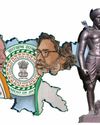As technologies to tap the sun and store its energy become more efficient, we are already on our way to an incredibly energy-affluent world. And chances are we might arrive there before development driven by fossil fuels brings on a climate-change apocalypse.

In the near future, the sun will come closer to you—so will the wind take up residence nearby. In a friendly neighbourhood battery, that is. The lithium-ion battery that runs your smartphone today could soon power Indian homes, cars and offices alike. This isn’t the stuff of science fiction, but a reality in the making. It already is a reality, for a small percentage of homes in countries such as the US and Germany. The scenario is doubly tempting: one, because of the vastly improved ways in which the Indian sun will soon be harvested; and two, because of how the big push towards renewable energy is accompanied by a technological leap in batteries—how they can trap, store and deliver power.
As India battles perhaps its deepest conflict—how to move towards an energy-intensive future without imperilling that very future—the path has to inevitably lead away from fossil fuels to renewable sources of energy. But how does one make, say, solar energy available on tap? It’s a field that has for long been marked by an infuriating blend of sheer plenitude—what could be more abundant in India than sun’s rays?—and a poverty of means. And its inherent lack of constancy is what had always hobbled solar energy. But what we are about to witness is a new paradigm: renewable energy being paired with the means to store it. Investment in batteries, therefore, is a necessary concomitant. Another moving object in the mirror that’s closer than it appears is electric vehicles. A future built around all this has its prophet in the shape of Tony Seba, Stanford academic and author of Clean Disruption, and he sees it all coming to fruition in just three years.
Diese Geschichte stammt aus der November 27, 2017-Ausgabe von Outlook.
Starten Sie Ihre 7-tägige kostenlose Testversion von Magzter GOLD, um auf Tausende kuratierte Premium-Storys sowie über 8.000 Zeitschriften und Zeitungen zuzugreifen.
Bereits Abonnent ? Anmelden
Diese Geschichte stammt aus der November 27, 2017-Ausgabe von Outlook.
Starten Sie Ihre 7-tägige kostenlose Testversion von Magzter GOLD, um auf Tausende kuratierte Premium-Storys sowie über 8.000 Zeitschriften und Zeitungen zuzugreifen.
Bereits Abonnent? Anmelden

Trump's White House 'Waapsi'
Donald Trump's victory in the US presidential election may very well mean an end to democracy in the near future

IMT Ghaziabad hosted its Annual Convocation Ceremony for the Class of 2024
Shri Suresh Narayanan, Chairman Managing Director of Nestlé India Limited, congratulated and motivated graduates at IMT Ghaziabad's Convocation 2024

Identity and 'Infiltrators'
The Jharkhand Assembly election has emerged as a high-stakes political contest, with the battle for power intensifying between key players in the state.

Beyond Deadlines
Bibek Debroy could engage with even those who were not aligned with his politics or economics

Portraying Absence
Exhibits at a group art show in Kolkata examine existence in the absence

Of Rivers, Jungles and Mountains
In Adivasi poetry, everything breathes, everything is alive and nothing is inferior to humans

Hemant Versus Himanta
Himanta Biswa Sarma brings his hate bandwagon to Jharkhand to rattle Hemant Soren’s tribal identity politics

A Smouldering Wasteland
As Jharkhand goes to the polls, people living in and around Jharia coalfield have just one request for the administration—a life free from smoke, fear and danger for their children

Search for a Narrative
By demanding a separate Sarna Code for the tribals, Hemant Soren has offered the larger issue of tribal identity before the voters

The Historic Bonhomie
While the BJP Is trying to invoke the trope of Bangladeshi infiltrators”, the ground reality paints a different picture pertaining to the historical significance of Muslim-Adivasi camaraderie